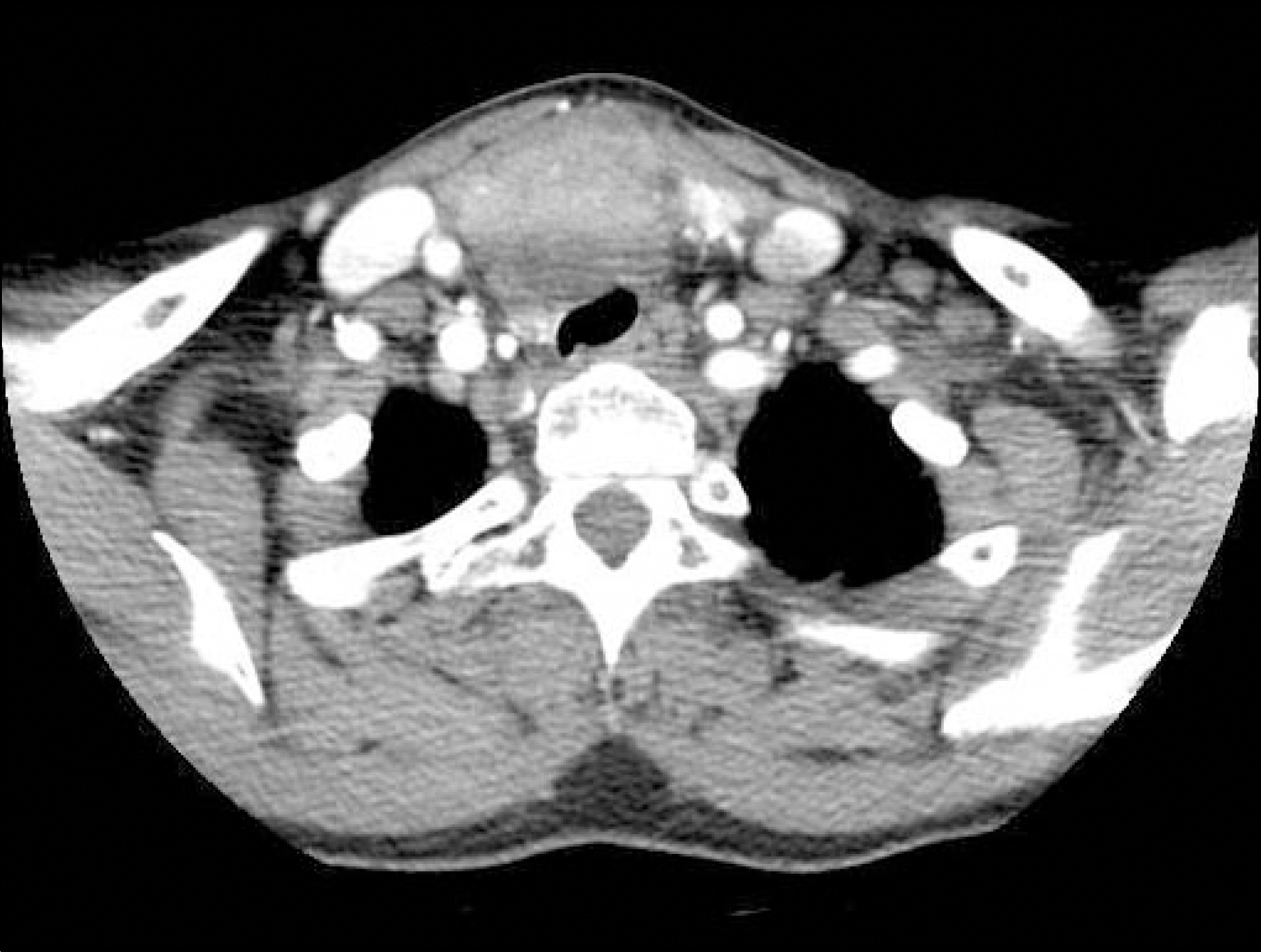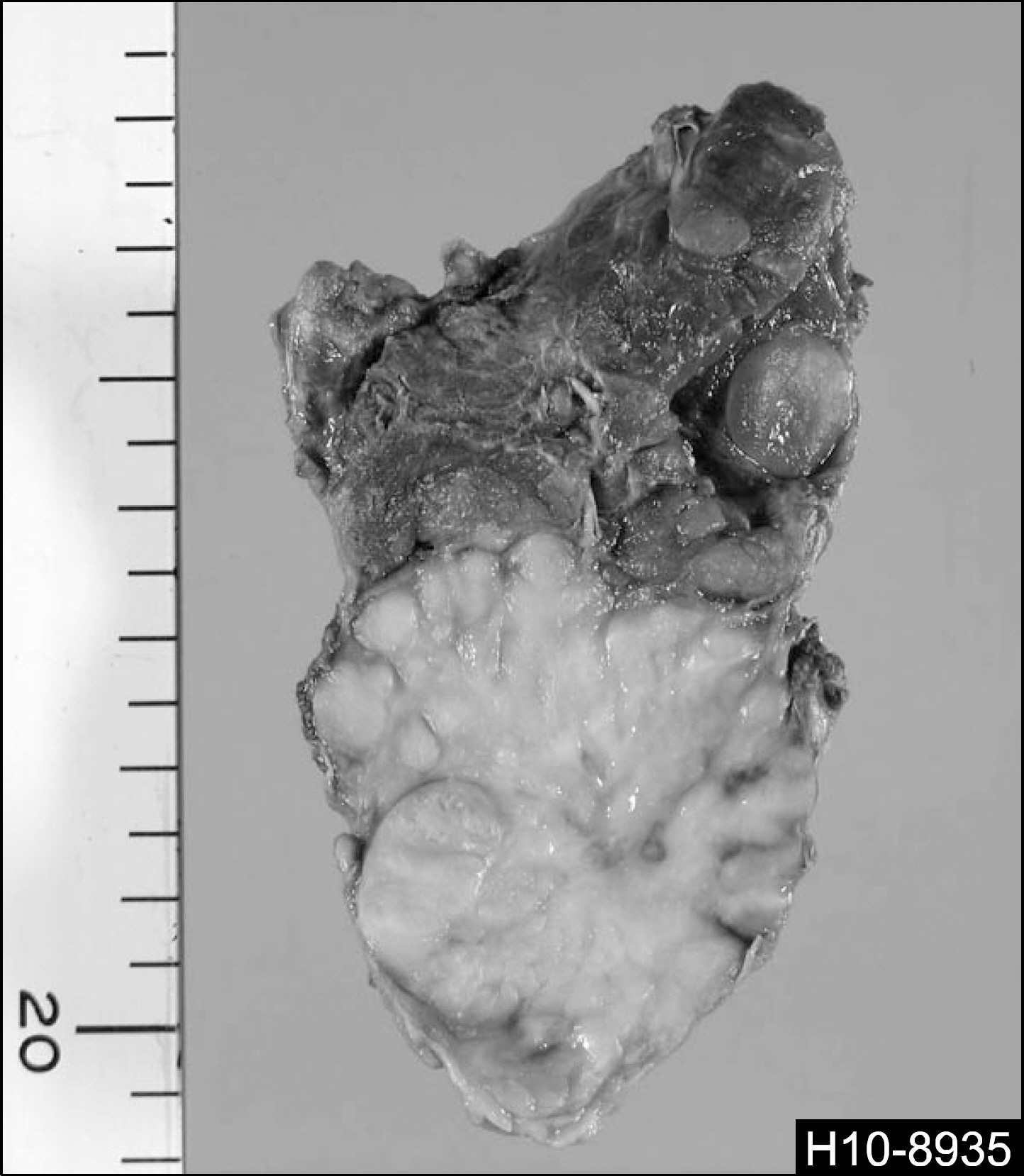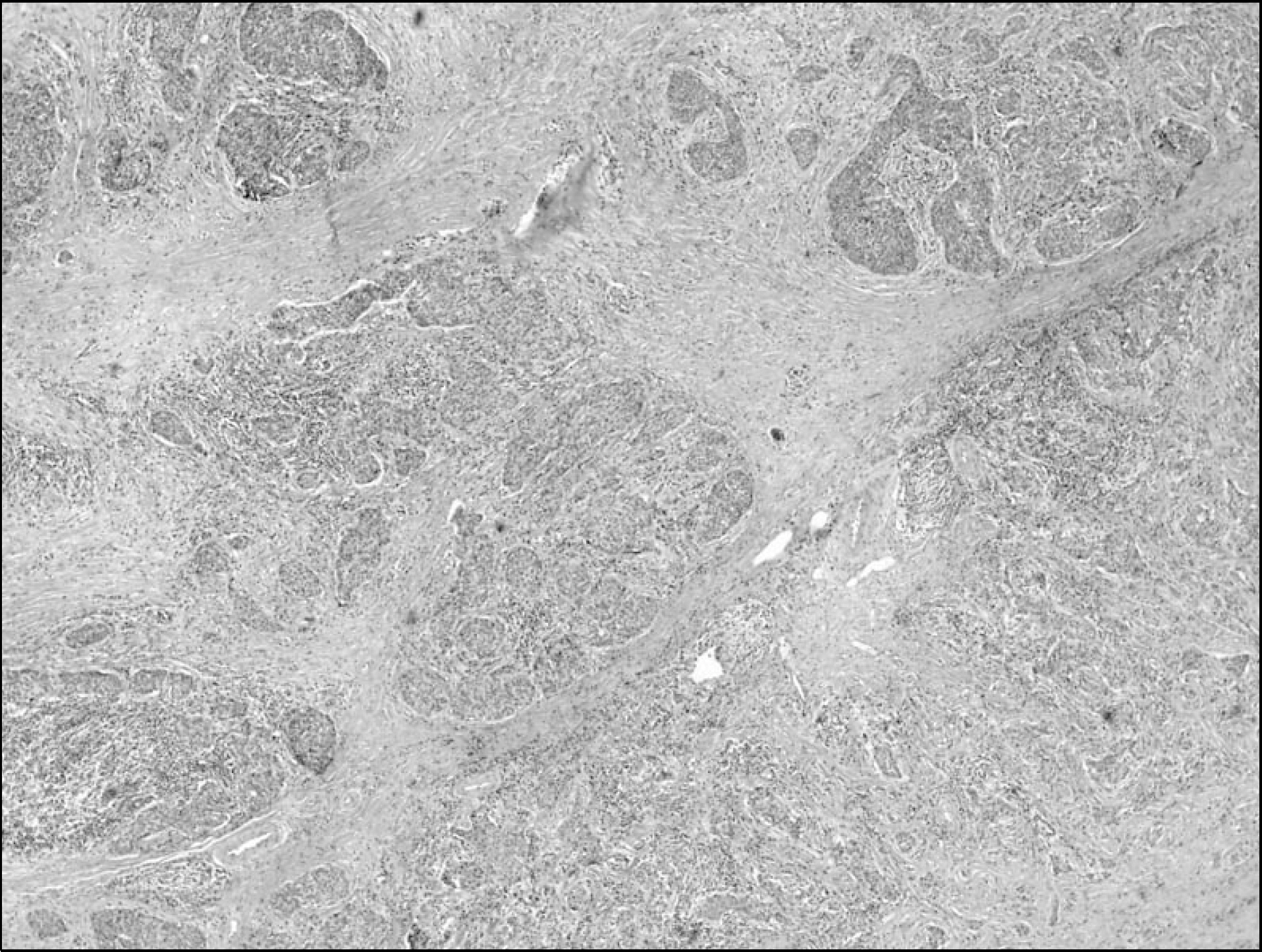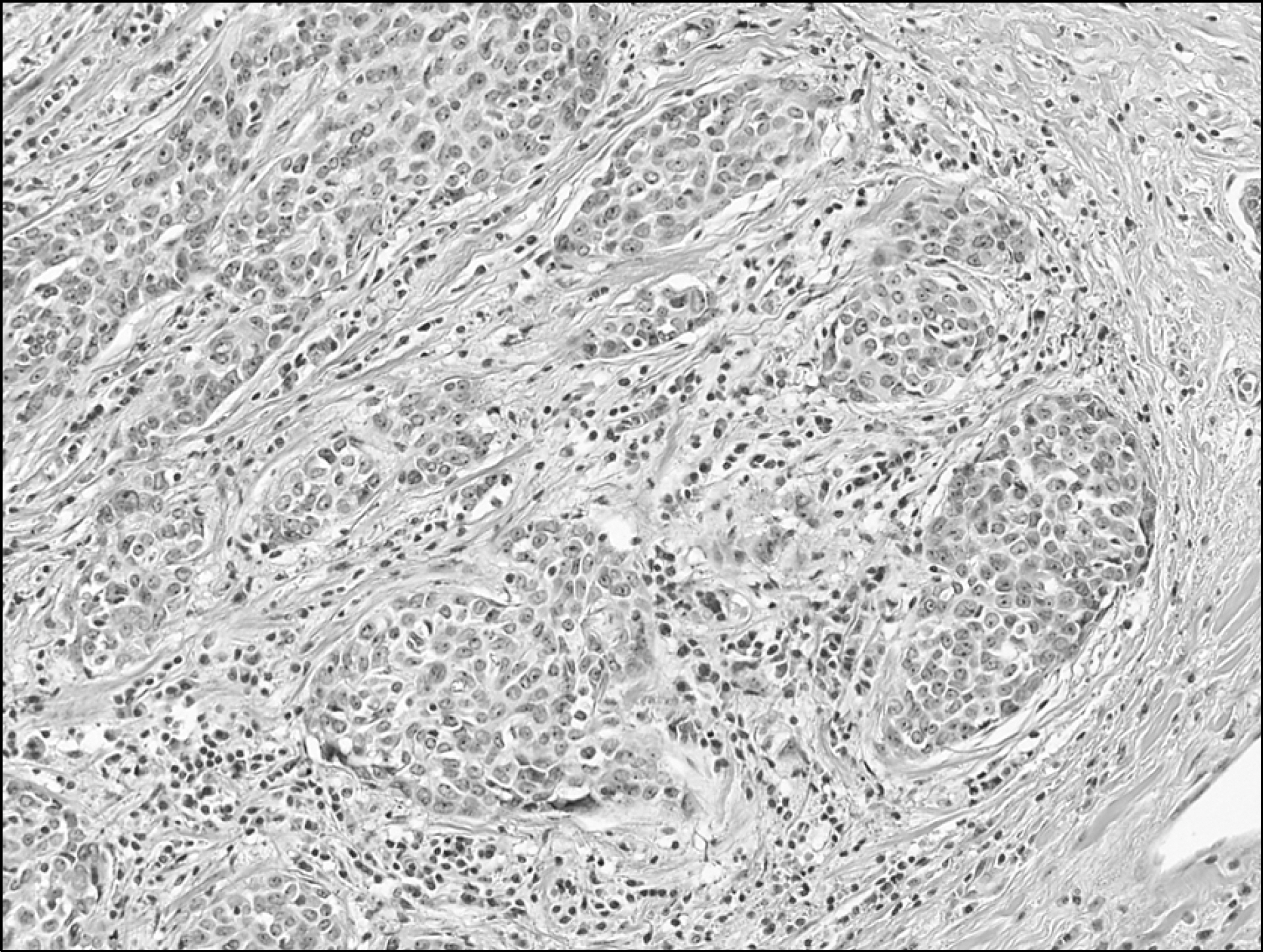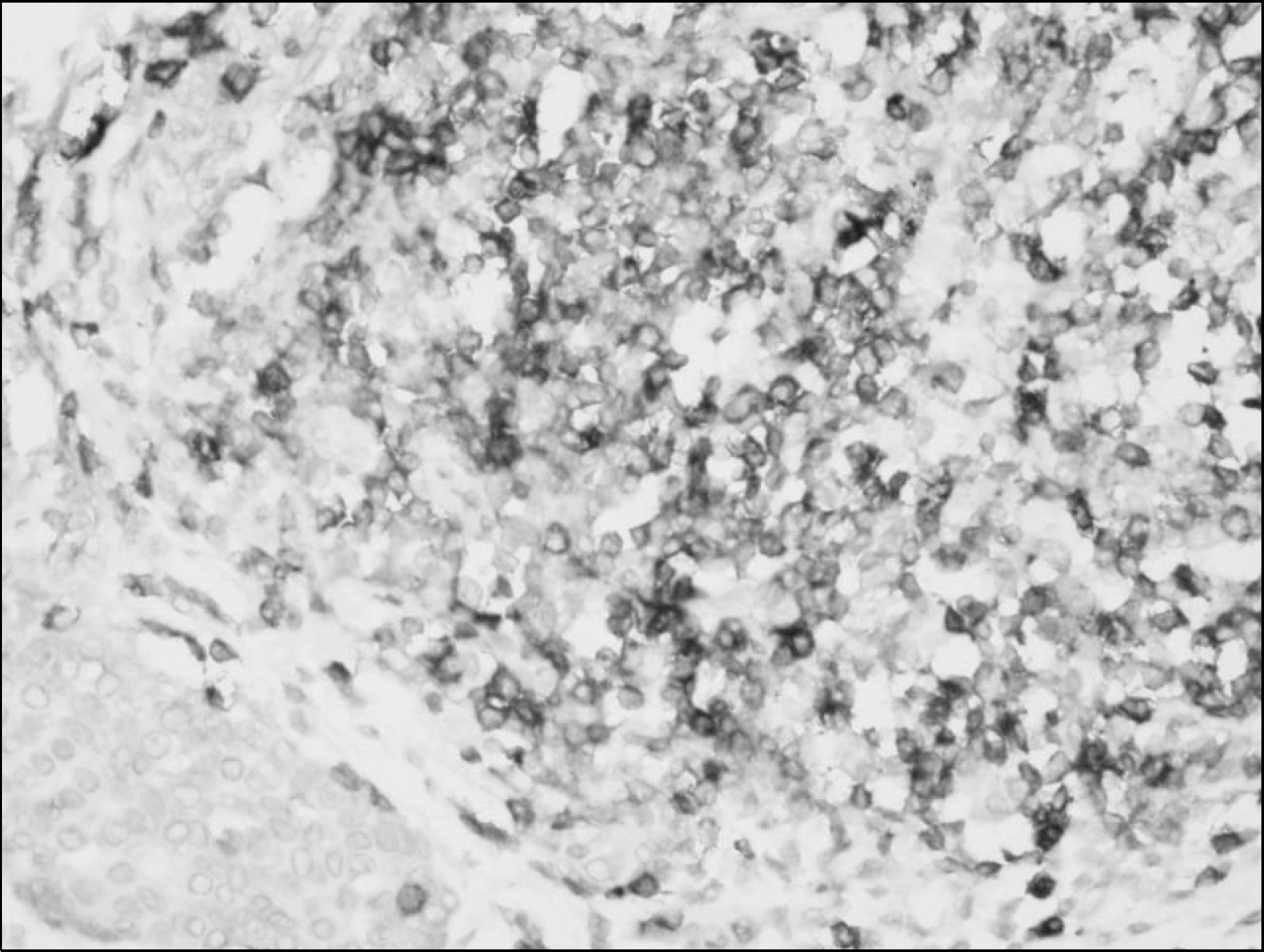Korean J Endocr Surg.
2011 Dec;11(4):292-296. 10.0000/kjes.2011.11.4.292.
Carcinoma Showing Thymus Like Differentiation (CASTLE): A Case Report
- Affiliations
-
- 1Department of Surgery, Inha University Medical School, Incheon, Korea. ksj1511@inha.ac.kr
- 2Department of Pathology, Inha University Medical School, Incheon, Korea.
- KMID: 2375393
- DOI: http://doi.org/10.0000/kjes.2011.11.4.292
Abstract
- Carcinoma showing thymus-like differentiation (CASTLE) is a very rare malignant neoplasm of the thyroid, which resembles lymphoepithelioma or squamous cell carcinoma of the thymus. It originates from ectopic thymic tissue or remnants of the branchial pouches. We recently experienced a case of CASTLE in the thyroid gland of a 65-year-old woman. The patient presented with a non-tender mass in the right thyroid gland and dyspnea and coughing upon bending. The patient was diagnosed with "˜cystic change of adenomatous goiter' of the thyroid by fine needle aspiration cytology. Right thyroidectomy was performed because of nodular hyperplasia on frozen biopsy. Histologic examination of the resected tumor showed that the tumor was lobulated and expansive growth pattern, with fibrous septa dividing the tumor and infiltrated by lymphocytes and plasma cells. Tumor cells possessed oval, large vesicular nuclei and prominent nucleoli, and the immunohistochemical staining was positive for CD5. The patient was diagnosed with thyroid CASTLE. We performed complete thyroidectomy. There has been no local regional recurrence.
Keyword
MeSH Terms
Figure
Reference
-
1.Miyauchi A., Kuma K., Matsuzuka F., Matsubayashi S., Kobayashi A., Tamai H, et al. Intrathyroidal epithelial thymoma: an entity distinct from squamous cell carcinoma of the thyroid. World J Surg. 1985. 9:128–35.
Article2.Chan JK., Rosai J. Tumors of the neck showing thymic or related branchial pouch differentiation: a unifying concept. Hum Pathol. 1991. 22:349–67.
Article3.Damiani S., Filotico M., Eusebi V. Carcinoma of the thyroid showing thymoma-like features. Virchows Arch A Pathol Anat Histopathol. 1991. 418:463–6.
Article4.Ito Y., Miyauchi A., Nakamura Y., Miya A., Kobayashi K., Kakudo K. Clinicopathologic significance of intrathyroidal epithelial thymoma/carcinoma showing thymus-like differentiation: a collaborative study with Member Institutes of The Japanese Society of Thyroid Surgery. Am J Clin Pathol. 2007. 127:230–6.5.Ahuja AT., Chan ES., Allen PW., Lau KY., King W., Metreweli C. Carcinoma showing thymic like differentiation (CASTLE tumor). AJNR Am J Neuroradiol. 1998. 19:1225–8.6.Roka S., Kornek G., Schüller J., Ortmann E., Feichtinger J., Armbruster C. Carcinoma showing thymic-like elements–a rare malignancy of the thyroid gland. Br J Surg. 2004. 91:142–5.
Article7.Kakudo K., Mori I., Tamaoki N., Watanabe K. Carcinoma of possible thymic origin presenting as a thyroid mass: a new subgroup of squamous cell carcinoma of the thyroid. J Surg Oncol. 1988. 38:187–92.
Article8.Hishima T., Fukayama M., Fujisawa M., Hayashi Y., Arai K., Funata N, et al. CD5 expression in thymic carcinoma. Am J Pathol. 1994. 145:268–75.9.Dorfman DM., Shahsafaei A., Miyauchi A. Intrathyroidal epithelial thymoma (ITET)/carcinoma showing thymus-like differentiation (CASTLE) exhibits CD5 immunoreactivity: new evidence for thymic differentiation. Histopathology. 1998. 32:104–9.
Article10.Berezowski K., Grimes NM., Gal A, et al. CD5 immunoreactivity of epithelial cells in thymic carcinoma and CASTLE using paraffinembedded tissue. Am J Clin Pathol. 1996. 106:483–6.11.Kusada N., Hara Y., Kobayashi S., Weihua T., Nakamura Y., Kakudo K, et al. A case of aggressive carcinoma showing thymus-like differentiation with distant metastases. Thyroid. 2005. 15:1383–8.
Article12.Da J., Shi H., Lu J. Thyroid squamous-cell carcinoma showing thymus-like element (CASTLE): a report of eight cases. Zhonghua Zhong Liu Za Zhi. 1999. 21:303–4.13.Piacentini MG., Romano F., De Fina S., Sartori P., Leone EB., Rubino B, et al. Carcinoma of the neck showing thymic-like elements (CASTLE): report of a case and review of the literature. Int J Surg Pathol. 2006. 14:171–5.
Article
- Full Text Links
- Actions
-
Cited
- CITED
-
- Close
- Share
- Similar articles
-
- Carcinoma Showing Thymus-Like Differentiation (CASTLE) of the Thyroid Gland: A case report
- Carcinoma Showing Thymus-like Differentiation (CASTLE) with Non-Recurrent Laryngeal Nerve: A Case Report
- Cytologic Findings of Thyroid Carcinoma Showing Thymus-like Differentiation: A Case Report
- A Case of Carcinoma Showing Thymus-Like Differentiation
- A Case of Carcinoma Showing Thymus-Like Differentiation (CASTLE) in the Thyroid


